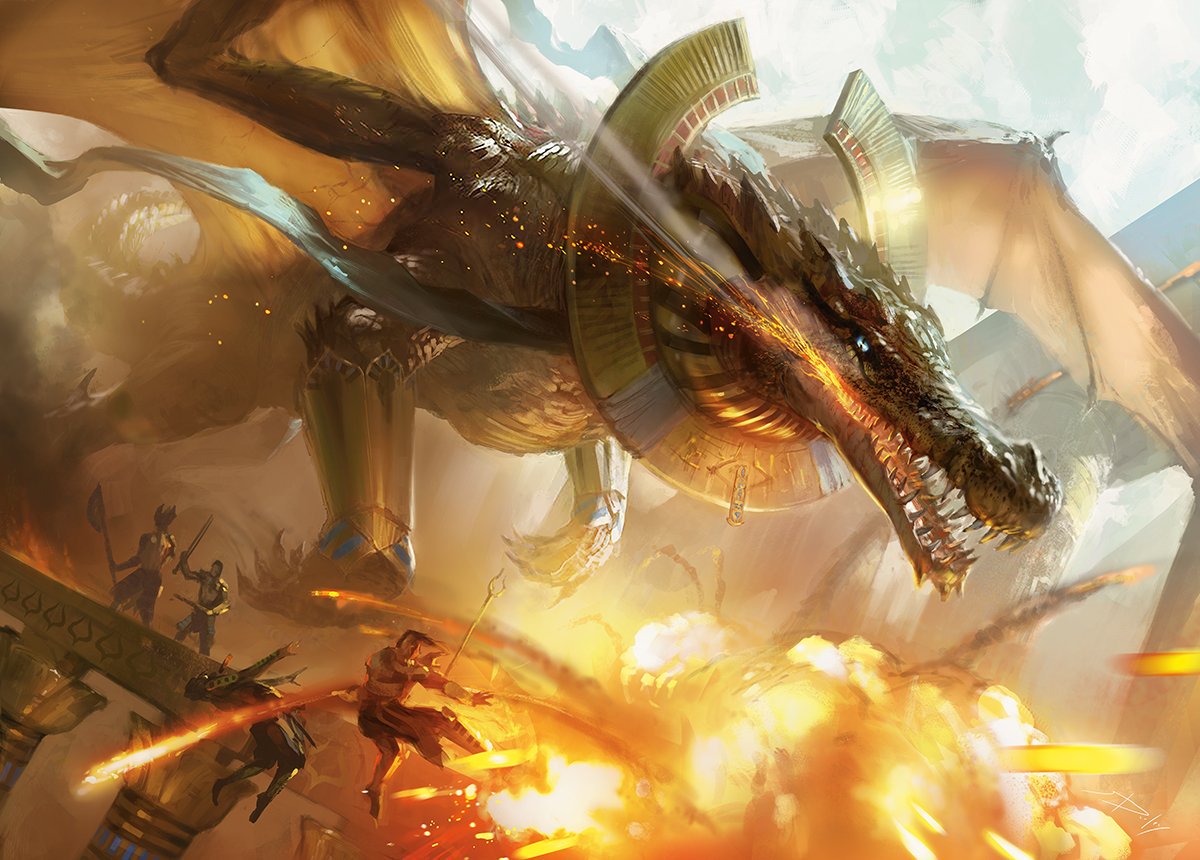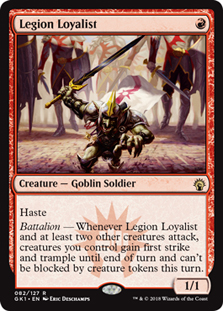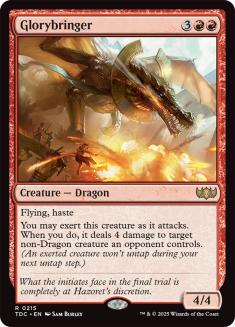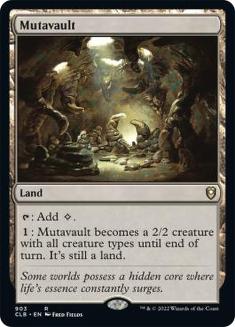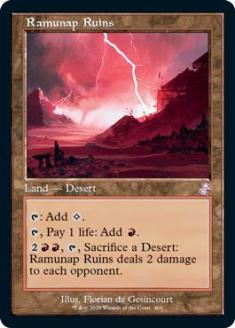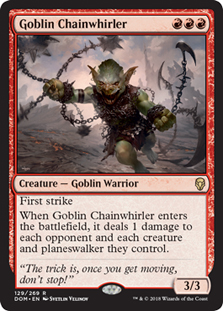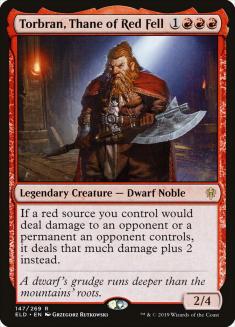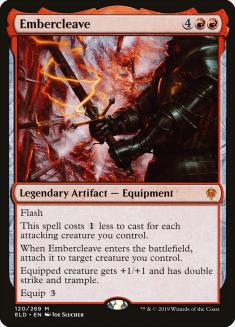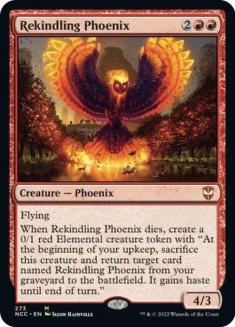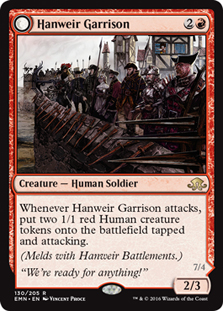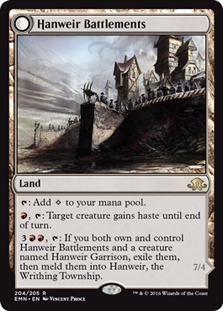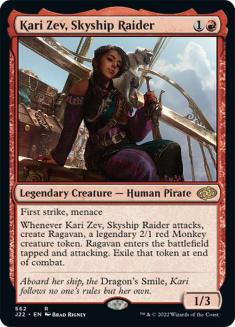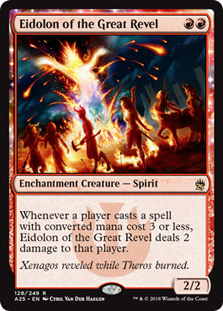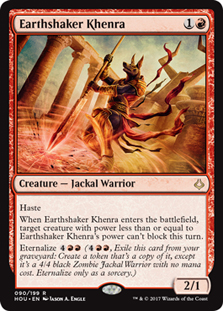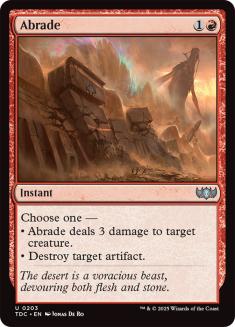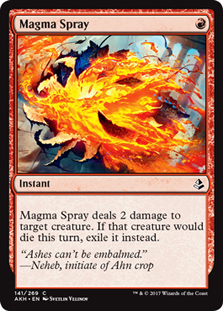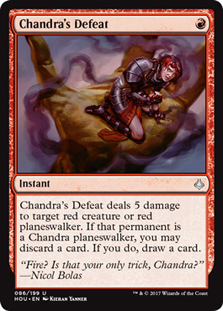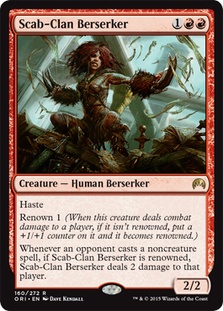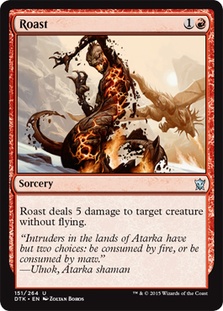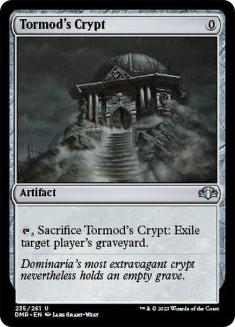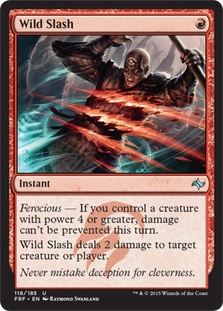It seems like Big Chonky Red is all the rage. But what is Big Chonky Red?
I’ve written about this deck already, but that was a long time and many iterations ago. The last time I was working on it, Legion Loyalist was still the primary one-drop creature, and Thought-Knot Seer was still being considered as the four-drop of choice. Before the banning of Field of the Dead, Legion Loyalist was a great creature for that slot. Making opposing tokens unable to block was huge, but giving Goblin Rabblemaster trample and first strike was also a big deal.
Nowadays, it seems like we’ve finally figured out what the best decks are now that we got a lot of the scary cards out of the format. Without Field of the Dead running around, threats like Legion Loyalist are no longer necessary. But what should be in its place? And what else has changed since then?
After going 5-0 in a few different events on Magic Online, people started to copy my list, and it seems like everyone is having success with it so far. But after talking to a few people who picked it up, it’s pretty clear that there are some misconceptions about the archetype. So while I will be giving you my updated Chonky Red list, there are some important reasons behind some of the card decisions that you need to hear. Before we dive into things, here’s the list I settled on before Christmas Vacation.
Creatures (22)
- 4 Goblin Rabblemaster
- 2 Kari Zev, Skyship Raider
- 4 Glorybringer
- 4 Soul-Scar Mage
- 2 Legion Warboss
- 4 Bonecrusher Giant
- 2 Torbran, Thane of Red Fell
Planeswalkers (3)
Lands (26)
Spells (9)
Sideboard

The maindeck is perfect. I don’t know how else to say it. Or, to be more clear, the maindeck has been perfect for the last three weeks, though I feel that is slowly starting to change. I’ve been experimenting with a few different builds, and I’ll be talking about those potential differences today as we dive head-first into all things Chonky Red.
Nothin’ but the Chonk
First of all, this version of red is called Chonky Red for one reason: it’s significantly “thicker” than your traditional red deck. The creatures are curving higher, and our top-end caps out at Glorybringer. And while it was a bit more chonky in the past, back when we were still playing Eldrazi creatures along the curve, we’re still significantly bigger than your traditional red deck.
It’s hard to describe just how good Glorybringer is in this format. At the top-end of the curve, Glorybringer hammers opposing creatures while pressuring life totals and planeswalkers alike. Glorybringer having haste and flying is almost as important as the exert ability that dumpsters an opposing creature. The ground gets gummed up quite easily in Pioneer, which means that the exert ability of Glorybringer is almost always going to be turned on.
To call this an aggro deck would be a mistake. At its heart, we’re actually a midrange deck. While we do have an aggressive slant thanks to hard-hitting threats like Goblin Rabblemaster, our deck is designed to be flexible by nature. In any given matchup against any random opponent, we can transition from being the aggressor in the situation to the control player. Our removal package being burn-based and our creatures generating virtual two-for-one trades mean we can turn the corner in a hurry.
But above all else, Chonky Red is designed to use nearly all of its mana every single turn.
There are 26 lands in this deck because we have so many great utility lands. Curving into Glorybringer is difficult without a high land count, so making sure your lands also have great abilities means you get to play more lands without actually flooding out too often. As long as you have something to do with that mana, playing more lands is ideal.
Mutavault is particularly great in this deck because it gives you a way to pressure an opposing planeswalker without much effort. As the game goes along, turning one extra mana into an attacker is relatively easy. And with such efficient removal as Wild Slash and Lightning Strike in the deck, clearing out potential blockers is not even a chore.
Ramunap Ruins is also pretty sick for helping you close out games. I don’t recommend throwing burn at your opponent’s face unless you’re getting them close to death, but Ramunap Ruins certainly helps influence some of that burn math as you approach the mid- and late-game. So many of your spells and lands can deal damage to the opponent that you can reasonably expect to kill your opponent from six or so life before they kill you if they don’t have much of a clock.
On Goblin Chainwhirler
In my opinion, Mutavault is the reason to play Chonky Red. A lot of people who pick up the deck keep telling me they think Goblin Chainwhirler is the new hotness, giving you some really powerful mid-game draws. In my experience, adding Goblin Chainwhirler means you have to cut some number of Mutavault. And if I know anything about Chonky Red, it’s that Mutavault is one of the top three cards in the whole deck.
Goblin Chainwhirler is a really powerful Magic card and pairs nicely with Torbran, Thane of Red Fell to clean up mid-sized creatures. Against opponents who go wide on the battlefield, Goblin Chainwhirler is going to be a house. But in my experience, most creatures that die to Goblin Chainwhirler must be killed in the early-game or else they threaten to get out of control. Just think about it: can you really afford to let your opponent untap with Llanowar Elves? No, you’re going to kill it with fire before they get a chance to play a large monster.
Let me be absolutely clear: there will likely be a metagame shift where Goblin Chainwhirler is wanted and will shine. But right now, Mutavault is far too powerful and necessary for the deck’s success. But don’t let your judgment be clouded, as changes like this are necessary for a deck’s evolution and survival.
Torbran and Goldfishing
Some matchups require you to be faster than normal. Torbran, Thane of Red Fell allows you to goldfish faster than your deck would normally be able to win. When combined with Goblin-makers, Torbran starts to output a significant amount of burst damage. In all honesty, Torbran wins you games you have absolutely no business winning. It’s your X-factor. It’s your Get Out of Jail Free card. It gives you a sliver of a chance against matchups where you’re a huge underdog.
Curving naturally into Torbran usually means your damage output is outrageous, but it’s another one of those cards that gets much worse as your opponent interacts with you more. As a result, Torbran is one of the cards that I sideboard out the most.
Torbran is a significant part of the deck as it stands right now, but these are what I would consider the flex spots. I keep two copies of Torbran and one Embercleave hanging around so that I can steal games that I couldn’t normally win. Embercleave, like Torbran, is sideboarded out quite a bit, but that doesn’t stop it from being one of the most dynamic and explosive cards in your arsenal.
The second Embercleave in the sideboard is to give your strategy another one of those goldfish cards that help against combo or ramp decks. If your opponent has a lot of removal in their deck, cards like Embercleave and Torbran should be the first you look to sideboard out. Even if it won you the first game, sideboard games tend to slow down and be much more interactive from both ends. Both players will have access to more ways to interact, and that’s the opposite scenario where either of these cards are very good.
In the future, if the format becomes much more about being interactive, I highly recommend Rekindling Phoenix in the Torbran slot. It’s versatile, powerful, and difficult to kill. When Rekindling Phoenix was in Standard, people came ready with the likes of Vraska’s Contempt and other exiling removal spells. In Pioneer, those effects are inefficient, and Rekindling Phoenix is a great sideboard option for opponents who are going extra hard on removal spells.
Tension in the Ranks
There are a few slots in the archetype that are contentious. Most people have stuck to the original 60-card maindeck, but other have deviated. And I myself have also been looking at newer builds and potential ways to improve the deck against specific opponents. For example, did you know that Azorius Control is a pretty bad matchup? But a few little changes here and there can much it much more palatable.
Giving your creature haste is a big deal, and having army-in-a-can creatures that your opponent has to kill immediately or expend a Supreme Verdict on is a big deal. Legion Warboss does a great job of that alongside Goblin Rabblemaster, but older iterations utilized both of these cards to great effect. And while the meld mechanic is pretty cool, it’s not even close to the reason for playing both of these cards.
Hanweir Battlements is just secretly a good card. Giving haste to Bonecrusher Giant or Goblin Rabblemaster is sick, but just having the threat of giving any medium-sized creature haste gives your deck an angle of attack your control opponent might not be able to handle. And hey, in a pinch, you can certainly create Hanweir, the Writhing Township if your opponent’s shields are down.
Hanweir Garrison also has three toughness, and in a format where Wild Slash and Bonecrusher Giant are popular, that is a big deal. I’ve talked at length on stream about how three toughness was actually a breaking point in Pioneer, simply because two of the premier removal spells in the format just can’t touch it. I expect I’ll be putting Hanweir Garrison back in my deck soon, and especially so if the mirror becomes much more popular. Outside of Lightning Strike, there aren’t a lot of ways to kill it in the early turns.
I don’t think many people have thought about cutting Kari Zev, Skyship Raider. In fact, after playing with it once, most people want to add a third. Remember that thing I said about three toughness? Well, if any creature can supplant Kari Zev in the two-drop slot, it’s Eidolon of the Great Revel. When you’re on the play, it’s a great threat against Azorius Control or some of the combo decks in the format. However, some combo decks can practically ignore it. Lotus Field or graveyard strategies like Sultai Dredge can largely ignore it, as I don’t have the required pressure to present lethal even if it triggers a few times.
Earthshaker Khenra can also potentially fill the slot, as it gives you some early pressure while also having some play in the later turns. If you want to fit either Eidolon of the Great Revel or Earthshaker Khenra into the deck, I expect you’ll need to make quite a few changes to make them actively good. In fact, I doubt Earthshaker Khenra is worthwhile at all without something like Bomat Courier to pressure in the early turns. Regardless, the two-drop slot is mostly empty and needs something to fill it. At the moment, that card is Kari Zev.
Sideboarding for the Future
As we explore the Pioneer format, it’s important to understand that all sideboards should be flexible. And depending on the popularity of a particular archetype and your vulnerability to it, you should put cards in your sideboard that will be significant in those matchups. For example, the Flavor of the Month back in December (after the bans) was Lotus Field. I played against it a ton, so I started playing three copies of Damping Sphere. Other people followed suit, and slowly the deck fell out of favor.
So later in the month, after I stopped playing against it, I cut them. But if the deck ever comes back, Damping Sphere is a great tool for helping you defeat them. Alongside the Torbran, Embercleave, and Scab-Clan Berserker, you actually have a chance of putting them in the ground. With that said, it’s important to keep updating your sideboard with the shifts in the metagame. At the moment, here are the decks I expect to play against and the cards I want in my sideboard to help fight them.
VS Mono-Black Aggro
The cheap removal at your disposal in the sideboard is mediocre outside of Magma Spray or similar. Their small threats need to be exiled, or else killing them doesn’t really do much long-term. The Vampire version isn’t the same, as their threats aren’t sticky, and any generic removal spells are okay against them.
VS Chonky Red
As this deck becomes more popular, having sideboard slots dedicated to it is important. In the last few weeks, the deck has risen to prominence, so having sideboard cards for the mirror is important for getting a leg up.
VS Azorius Control
Try to get under them, but also make sure you have two Fry to handle Teferi, Hero of Dominaria or Lyra Dawnbringer. If Azorius Control comes back in a big way, it might be correct to play three.
VS Mono-Green Aggro
Killing Lovestruck Beast is a huge deal. Lava Coil and Mizzium Mortars don’t quite do it, which means you probably need Roast instead of those as a way to actually handle that threat. However, if this deck decreases in popularity, it’s possible we should move back toward either of those removal spells.
VS Sultai Dredge
I chose Tormod’s Crypt because cards like Grafdigger’s Cage can be destroyed, unlocking the graveyard. All you need is to slow them down for a turn or two, as Tormod’s Crypt effectively turns them into a normal midrange deck. Obviously Tormod’s Crypt isn’t the most powerful anti-graveyard card, but it’s the one I chose and have had the most success with.
I understand that Eidolon of the Great Revel is an inherently stronger card than Scab-Clan Berserker. But I can only lose so many times with an Eidolon of the Great Revel on the battlefield before I start looking for a new way to interact. Scab-Clan Berserker is more expensive, and needs to connect before turning on, but it’s been significantly better for me against the combo and control decks in the format. Curves are slanting higher, which means less damage for Eidolon of the Great Revel to deal.
Like Tormod’s Crypt over Grafdigger’s Cage, it doesn’t make sense on paper, but neither does a Chonky Red deck being the best deck in Pioneer. It’s all relative.
New Chonk City
The Pioneer format isn’t quite “solved,” and every new set could have a lasting impact. The sideboard for Chonky Red is quite versatile, so I recommend just being open to changing stuff as certain decks become more or less popular. Like all midrange decks, it’s important that we remain flexible in both deckbuilding and sideboarding.
There are some experimental builds of Chonky Red which could prove fruitful, but the current builds are quite strong. As it becomes clear that Chonky Red is one of the better decks in the format, other midrange or control decks might crop up to fight it. We are far from the most grindy midrange deck in Pioneer, and anyone with a brain and a Bring to Light can figure out a way to go over the top of us. If people start playing the right removal and right threats, they can invalidate much of our strategy. Just last night, someone beat the heck out of me with Rotting Regisaur in Mono-Black Aggro!
Regardless, as these new threats pop up or decks adapt to our strategy, we must find new ways to fight back. For now, here is my current Chonky Red list, incorporating much of what we’ve already discussed.
Creatures (23)
- 4 Goblin Rabblemaster
- 3 Hanweir Garrison
- 2 Kari Zev, Skyship Raider
- 4 Glorybringer
- 4 Soul-Scar Mage
- 2 Rekindling Phoenix
- 4 Bonecrusher Giant
Planeswalkers (3)
Lands (26)
Spells (8)
Sideboard

This is where I’m at right now, but that will certainly change with the release of Theros Beyond Death. The next few weeks should be pretty fun for anyone looking for Pioneer content, as the new set will likely bring some cool changes. We’ve already established that Nykthos, Shrine to Nyx is a powerful card in the format, and all these new enablers could be quite strong.
Make sure you check out my Twitch channel where I’ll likely be streaming some different iterations of this archetype looking for the best build. The new set should be ready for Magic Online soon, and you can bet your bottom dollar I’ll be trying out all sorts of cool goodies from Theros Beyond Death in Pioneer.
These two cards are the same. If you don’t want to pay $5 for a Shock, then don’t. In the 50 or so matches I’ve played with the deck, I’ve only had the ferocious clause on Wild Slash come up a few times. And since the banning of Nexus of Fate, it’s only come up once. Save yourself $20. Play Shock.

